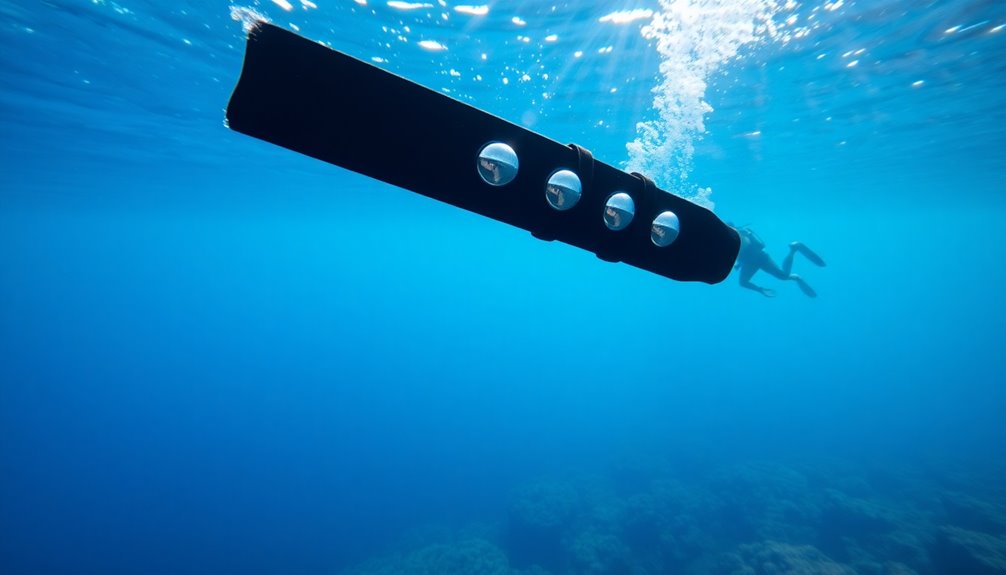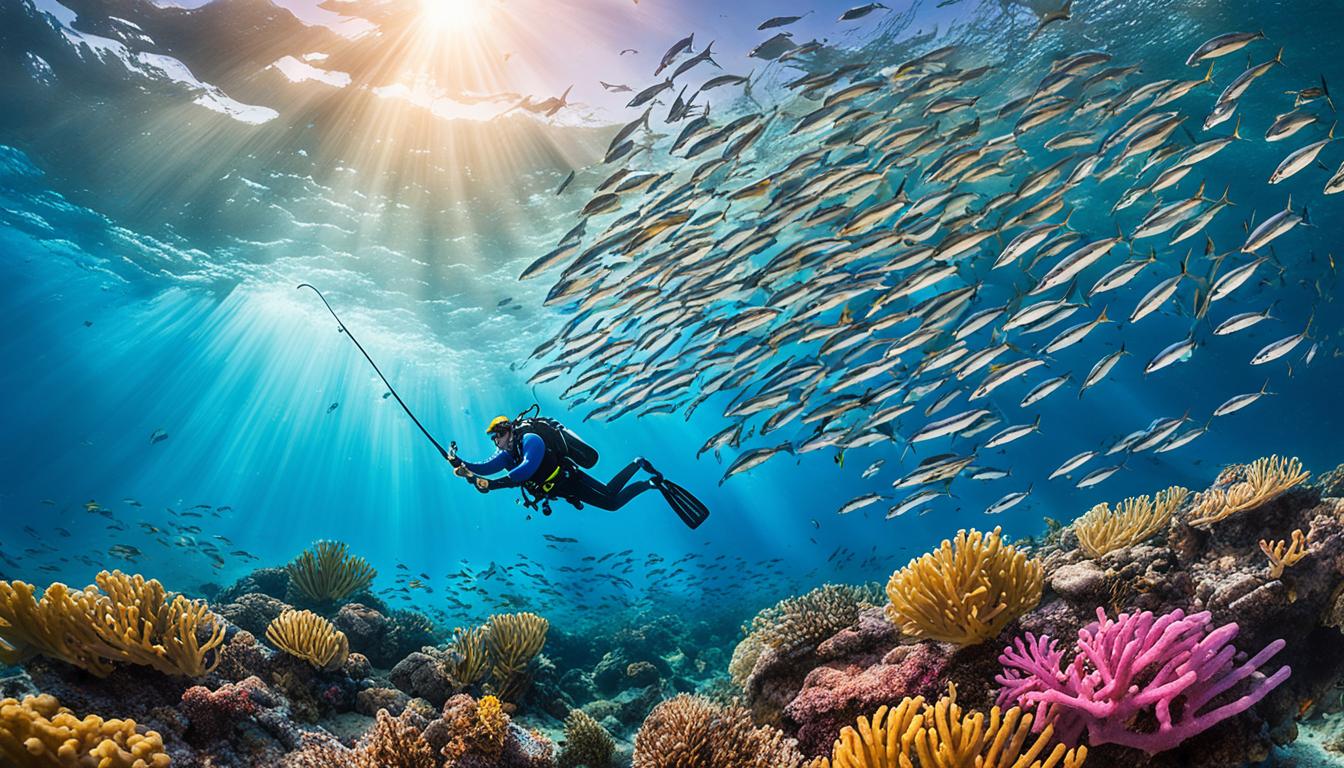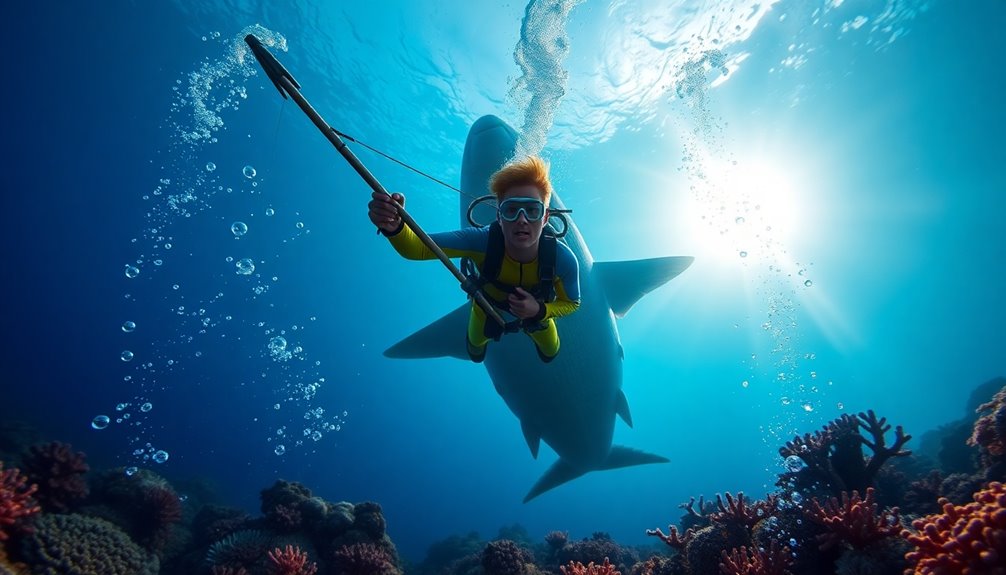A diver weight belt is essential for controlling your descent and achieving neutral buoyancy underwater. It allows you to move effortlessly, enhancing your overall diving experience. Rubber belts offer comfort and flexibility, while integrated weight systems provide even weight distribution. Quick-release mechanisms guarantee safety, letting you remove weights swiftly in emergencies. Always check your belt for wear and rinse it after use to prevent corrosion. Proper weighting helps maintain control during safety stops, and finding the right weight is key to mastering the depths. There's much more to explore about selecting the perfect weight system to elevate your diving skills!
Key Takeaways
- A properly fitted weight belt ensures neutral buoyancy, facilitating controlled descent and ascent during dives.
- Rubber weight belts provide comfort and prevent shifting, enhancing trim and buoyancy control underwater.
- Integrated weight systems streamline weight distribution and minimize bulk, improving overall diving efficiency.
- Regular maintenance and inspections of weight belts are essential for safety and optimal performance.
- Familiarize yourself with quick-release mechanisms to ensure rapid weight removal in emergencies.
Importance of Weight Belts
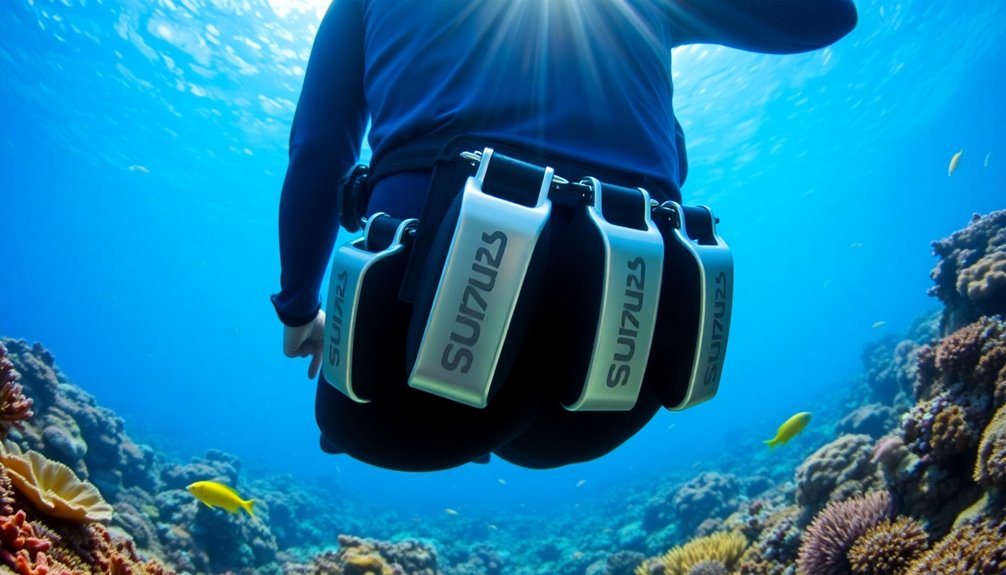
A weight belt is essential for every diver, as it helps you achieve neutral buoyancy. This balance allows you to control your descent and maintain a stable position underwater without excessive sinking or floating.
Proper weight distribution on your belt is critical for stability; ideally, you should position weights around the front of your hips. This enhances your trim and buoyancy control, making your diving experience more enjoyable.
Rubber weight belts are particularly beneficial due to their elasticity, offering automatic depth compensation and a secure fit that prevents sliding. They're often more comfortable than traditional nylon belts.
Safety is paramount in diving, and the quick-release mechanisms on weight belts greatly enhance that safety. In emergencies, you can rapidly remove your weights, reducing the risk of accidents.
Regular inspection and maintenance of your weight system are essential to guarantee safety. After each dive, rinse your weight belts in fresh water to prevent corrosion and damage.
Types of Weight Belts
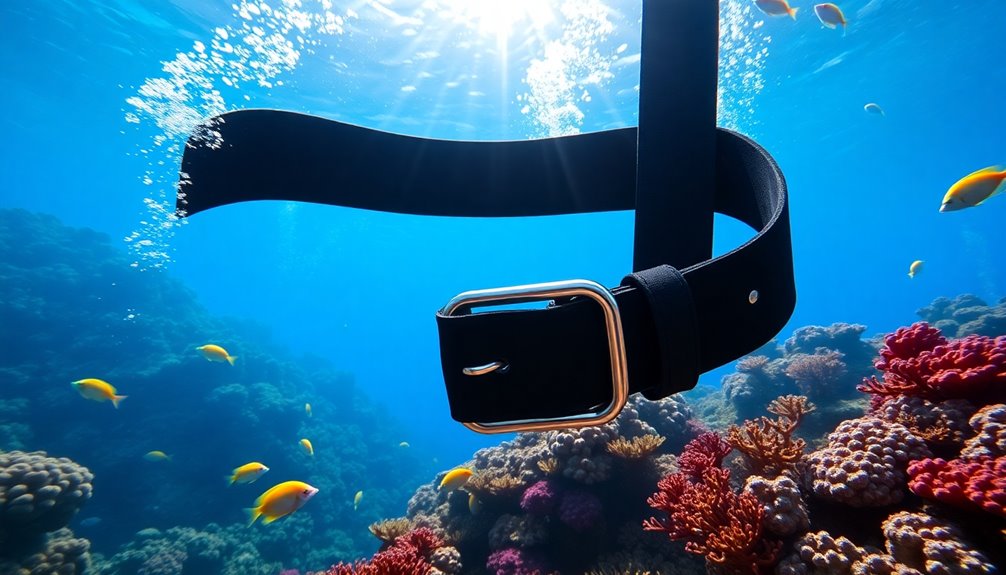
When choosing a weight belt, you'll notice some options offer distinct benefits and drawbacks.
For instance, rubber weight belts provide a secure fit, while nylon counterparts may slide and need constant adjustment.
Additionally, integrated weight systems streamline your setup but can complicate weight removal underwater. While integrated weight systems offer the convenience of a more streamlined profile, divers must weigh the trade-offs carefully. The potential complications in weight removal underwater can pose challenges in emergency situations, highlighting the importance of a thorough pre-dive check. Nevertheless, many enthusiasts argue that the underwater spear gun benefits gained from a well-fitted integrated system often outweigh these concerns, as it allows for better maneuverability and reduced drag in the water.
Rubber Weight Belts Benefits
Rubber weight belts provide a range of benefits that enhance your diving experience. One key advantage is their automatic depth compensation, thanks to their elastic properties, allowing you to maintain comfort and fit at varying depths.
The tacky surface guarantees stability by preventing any sliding or spinning on your wetsuit, giving you reliable weight distribution. This stability is essential for effective buoyancy control throughout your dive.
If you struggle with lower back issues, you'll appreciate how these belts can be worn lower on your body, alleviating lumbar pressure.
The unique assembly compresses the rubber for a secure fit, while the one-handed release mechanism enhances safety and ease of use.
Unlike nylon belts, which often require frequent adjustments due to weight shifting, rubber weight belts hold weights exceeding 20 lbs without moving.
This reliability means you can focus more on enjoying your dive rather than constantly readjusting your gear.
Nylon Weight Belts Drawbacks
While rubber weight belts offer numerous advantages, nylon weight belts come with their own set of drawbacks that can affect your underwater experience.
If you're considering using a nylon weight belt, here are some issues you might encounter:
- Sliding: Nylon weight belts are prone to sliding, requiring frequent adjustments that can be distracting during a dive.
- Discomfort: Over-tightening these belts can lead to discomfort and potential buckle failure, especially as your wetsuit compresses at depth.
- Misalignment: It's common for nylon belts to become misaligned during ascent, complicating buckle management while you focus on underwater tasks.
- Lack of Ergonomic Options: The fixed nature of nylon belts can create discomfort against your hips and back, prompting many divers to seek more adjustable and comfortable alternatives.
The overall dissatisfaction with nylon weight belts has led to a growing preference for more ergonomic options, such as rubber belts.
These alternatives provide better comfort and flexibility, making your dives more enjoyable.
Ultimately, understanding these drawbacks can help you make a more informed choice about the weight belt that best suits your diving needs.
Integrated Weight Systems Overview
Integrated weight systems revolutionize the way divers manage their buoyancy and weight distribution underwater. By combining buoyancy compensators (BCs) with built-in weight pockets, these systems allow you to distribute weight more evenly, enhancing your control and comfort.
Unlike traditional belts, integrated systems are streamlined, minimizing bulk and reducing the potential for shifting that can disrupt your dive.
One popular type is the DUI weight & trim harness, which offers shoulder suspension for added comfort and helps prevent slippage. You can also use cam band weights that attach directly to your BC straps, providing an efficient solution for underwater balance.
A vital feature of these systems is the quick-release mechanism. In emergencies, you can rapidly remove weights, establishing positive buoyancy quickly to guarantee your safety.
Many integrated systems recommend keeping your lead weight to around 12 lbs, promoting better stability and trim underwater.
Types of Diving Weights
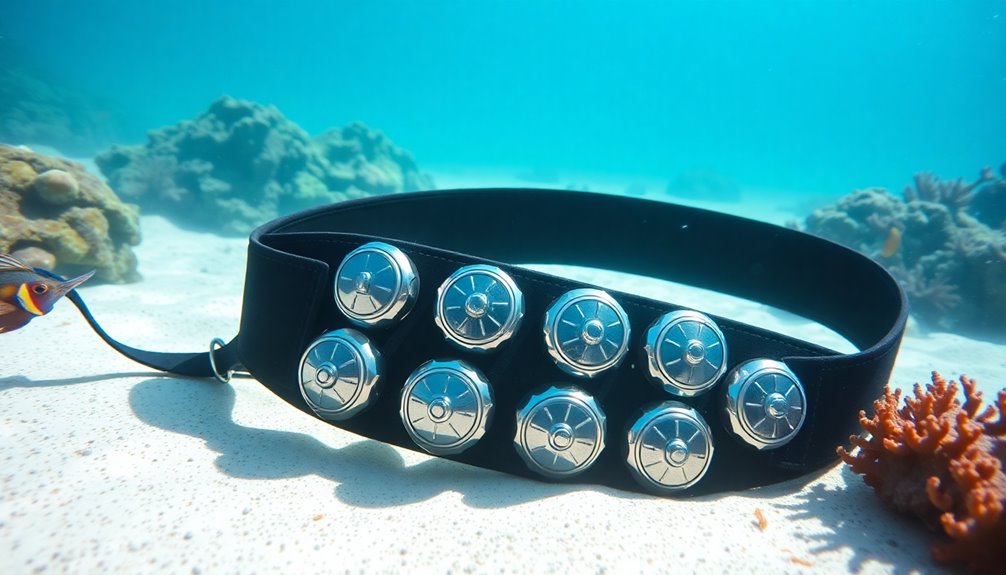
When you're choosing weights for your underwater adventures, understanding the different types is essential.
Hard weights offer durability and stability, while soft weights provide comfort and flexibility.
Integrated weight systems streamline your setup, making it easier to manage your buoyancy without extra belts.
Hard Weights Overview
Hard weights play an essential role in scuba diving, providing the necessary ballast to help you achieve neutral buoyancy underwater.
These weights, typically made of lead, are important for counteracting the buoyancy of your wetsuit and diving equipment, allowing for a controlled descent and stable positioning at depth.
When choosing hard weights, consider the following types:
- Standard Sizes: Commonly available in 2 lbs (900 grams) and 3 lbs (1.3 kg) for effective weight distribution.
- Shape: Often square-shaped with slits for secure attachment to your weight belt, ensuring a stable fit during dives.
- Material: Lead is preferred due to its high density, allowing you to achieve neutral buoyancy with less volume compared to alternatives.
- Positioning: Proper attachment and positioning on your weight belt are essential for achieving ideal balance and trim underwater.
Soft Weights Benefits
While hard weights are a popular choice among divers, soft weights offer several advantages that enhance comfort and performance underwater. Typically made of lead shot encased in a flexible bean-bag design, these weights provide a more enjoyable diving experience.
| Advantages | Details |
|---|---|
| Comfort | Soft weights distribute pressure evenly, reducing discomfort. |
| Buoyancy Control | They conform to your body shape for a streamlined fit, improving buoyancy control. |
| Versatility | Works well with pouch-style weight belts for easy adjustments. |
Using soft weights allows you to dive longer and with less fatigue, especially during recreational diving. Their ability to adapt to your body shape means you won't feel restricted by traditional hard weights. Plus, the pouch-style weight belts paired with soft weights make it simple to adjust your buoyancy as needed. As divers increasingly recognize these benefits, soft weights are becoming a favored option due to their comfort and versatility. Furthermore, understanding the critical periods in diving training can help maximize your buoyancy skills. So, if you're looking to enhance your underwater adventures, consider making the switch to soft weights for a more enjoyable diving experience!
Integrated Weight Systems
Integrated weight systems revolutionize the way divers manage buoyancy and stability underwater.
These systems allow for effective weight integration, distributing weight evenly across your Buoyancy Compensator (BCD). This enhances stability and guarantees ideal buoyancy control during your dives.
Here are some key features of integrated weight systems:
- Weight Pockets: Easily attach or detach weight pockets, giving you flexibility in your setup.
- Quick-Release Mechanisms: Safety is paramount; quick-release features enable swift weight removal in emergencies.
- Proper Trim: Adjust weight placement to achieve proper trim, minimizing the risk of misalignment while diving.
- Shoulder Suspension: Innovations like DUI weight & trim harnesses provide shoulder suspension for comfort and prevent slippage, enhancing your overall diving experience.
With these integrated weights, you can limit the lead used in your BCD to around 12 lbs.
This encourages a balance between weight distribution and traditional weight belts, allowing for a more enjoyable and stable dive.
Embrace the advancements in integrated weight systems, and elevate your diving experience today!
Benefits of Proper Weighting
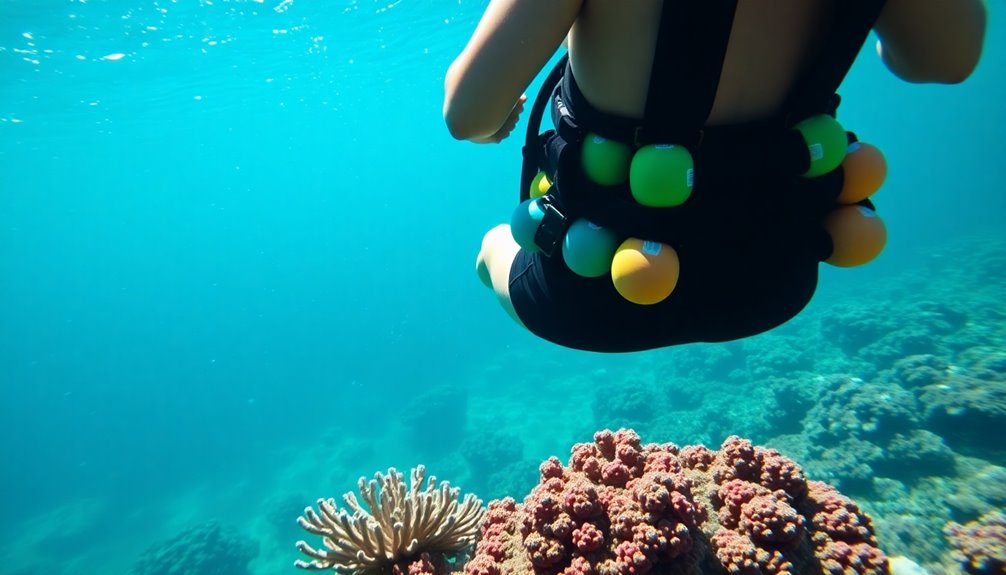
Achieving proper weighting is crucial for every diver, as it directly impacts your safety and comfort underwater. With the right weight distribution, typically around the front of your hips, you can achieve neutral buoyancy, making descents effortless and maintaining your position easier. This balance prevents excessive head-up or head-down positions, allowing you to concentrate on your plunge instead of struggling with your buoyancy.
It's essential to understand how diver mass, gear buoyancy, and water salinity affect your weight needs. Generally, weight requirements can range from 2 kg (4.4 lb) to 15 kg (33 lb) based on these factors. At the end of a dive, slight negative buoyancy helps maintain control during safety and decompression stops, ensuring you stay safe at various depths.
Finally, using quick-release mechanisms on your weight belt enhances safety, enabling you to drop weight quickly in emergencies.
| Benefit | Description | Impact |
|---|---|---|
| Neutral Buoyancy | Allows effortless movement underwater | Increased comfort |
| Ideal Weight Distribution | Prevents imbalance and enhances trim | Better diving control |
| Emergency Readiness | Quick-release mechanisms for safety | Promotes safer practices |
Safety Precautions for Weight Use
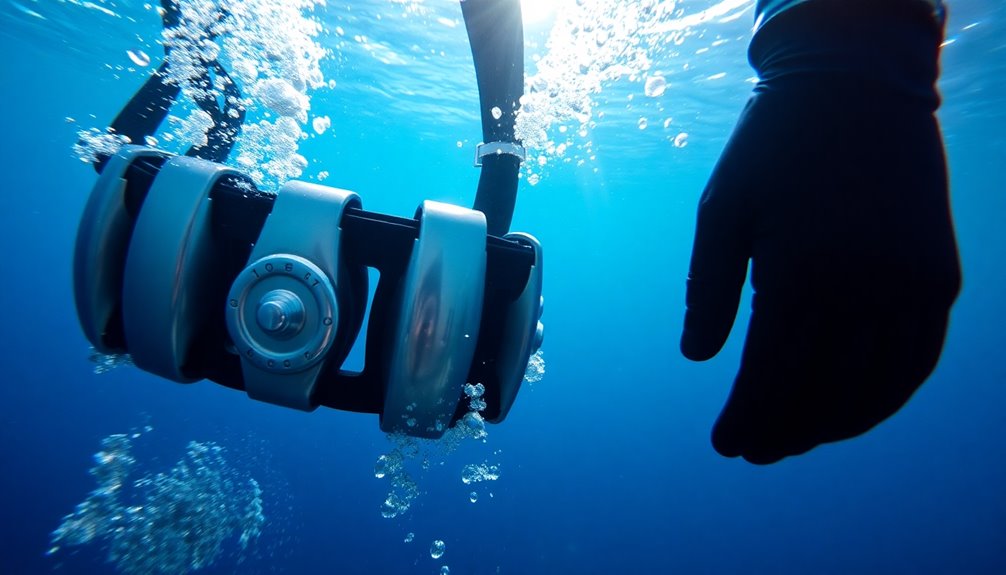
When diving, your weight belt plays an essential role in guaranteeing safety and stability underwater. Adopting the right safety precautions is vital for a successful dive. Here are some key measures you should follow:
- Conduct Buoyancy Checks: Before each dive, always perform a buoyancy check to confirm that your weight configuration allows for neutral buoyancy, especially if you're using new gear.
- Inspect Your Equipment: Regularly inspect your weights and belt for any signs of wear, corrosion, or damage. Maintaining equipment integrity is critical for safe diving practices.
- Familiarize with Quick-Release Mechanisms: Confirm that your weight systems have quick-release mechanisms that are easily accessible. Practice using them in controlled environments to enhance your emergency readiness.
- Aim for Slight Negative Buoyancy: At the end of your dive, aim for slight negative buoyancy to prevent rapid descents that could lead to dangerous situations underwater.
Maintenance of Weight Belts
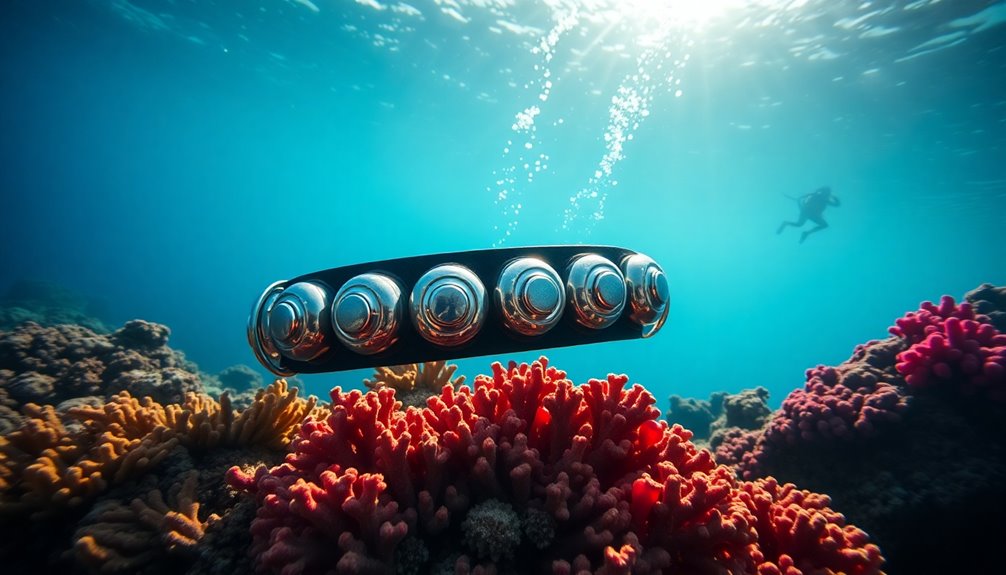
To guarantee your weight belt remains safe and reliable, proper maintenance is crucial. After each dive, make certain to rinse your weight belts and weights in fresh water to prevent corrosion and damage caused by saltwater or chlorine.
Regularly inspect your weight belt for signs of wear, like fraying or corrosion on the buckles, to guarantee they remain functional and safe for your dives. Additionally, ensure that the weight of your belt is appropriate for your diving conditions, as an improperly weighted belt can lead to struggles underwater. When preparing for a dive, it’s also essential to review safety protocols, including understanding rip currents, which can pose significant risks to divers. By taking these precautions and staying informed, you can enhance your overall safety and enjoyment while diving.
Allow your weight belts to dry in a shaded area, avoiding direct sunlight, which can weaken materials over time.
While you're at it, check your soft weights for clumping or water intrusion, as these issues can considerably affect their performance and safety.
If you notice any damage or signs of wear, don't hesitate to replace worn or damaged weights and belts promptly.
Keeping your equipment in top shape is crucial for peak safety and performance while diving. By adhering to these maintenance tips, you can enjoy your underwater adventures with peace of mind, knowing your gear is up to the task.
Choosing the Right Weight
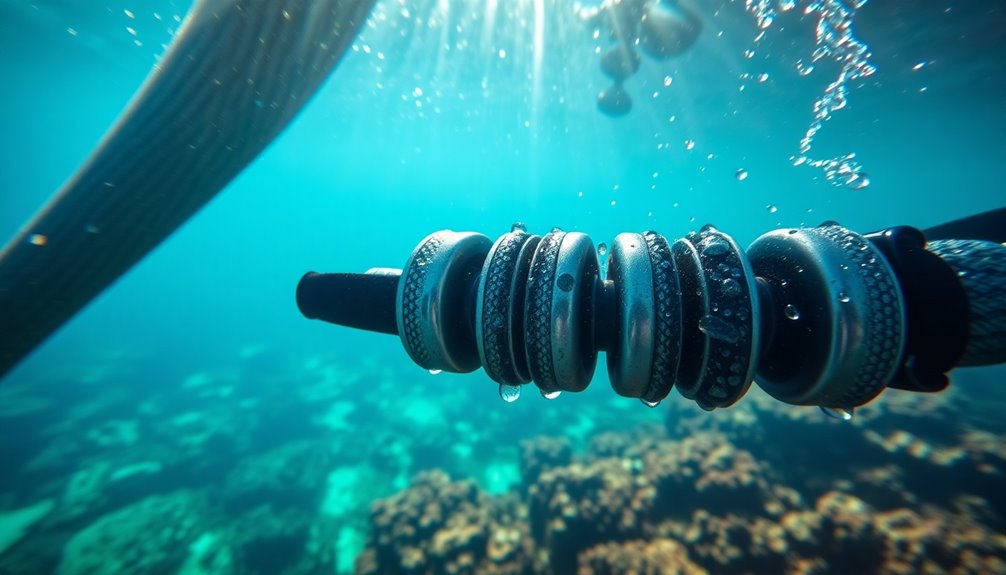
After ensuring your weight belt is well-maintained, the next step is selecting the right amount of weight for your diving experience.
Choosing the right weight is vital for achieving neutral buoyancy and enhancing your underwater control. The amount of weight needed typically ranges from 2 kg (4.4 lb) to 15 kg (33 lb), depending on several factors.
Here are key considerations to keep in mind:
- Body Weight: Heavier divers generally require more weight to counteract buoyancy.
- Gear Buoyancy: The buoyancy characteristics of your gear, like wetsuits or tanks, play a significant role.
- Water Conditions: Salinity and temperature affect buoyancy; saltwater is denser than freshwater.
- Weight Distribution: Properly weighted divers should distribute weight around their hips to maintain balance and trim.
Innovations in Weight Systems
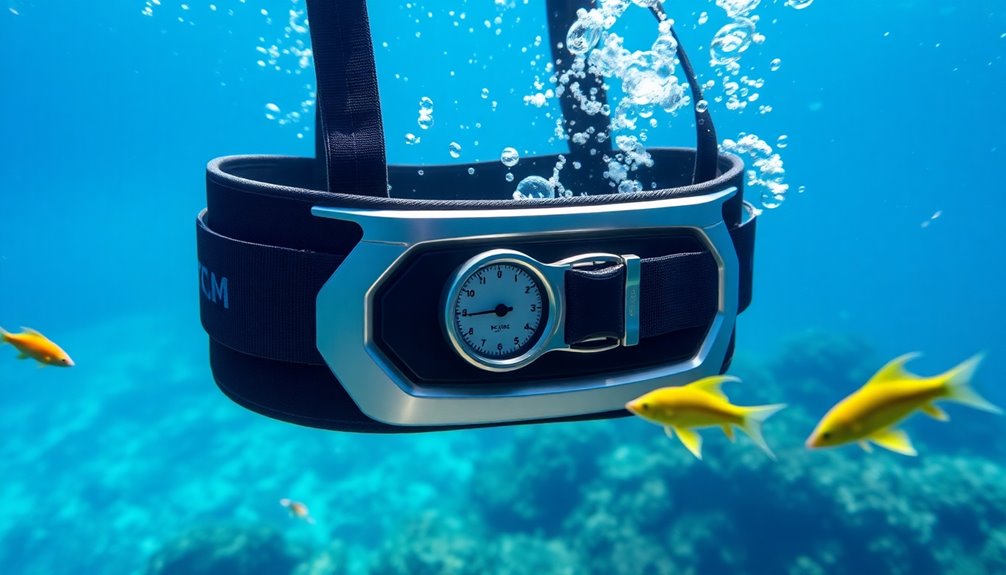
Recent advancements in weight systems have transformed how divers manage buoyancy and comfort underwater. One major innovation is the weight integrated buoyancy compensator (BC), allowing you to distribute weight conveniently without a separate belt. However, it's vital to limit lead in BCs to 12 lbs for safety.
The DUI weight & trim harness is another game changer, featuring shoulder suspension that enhances comfort and stability, preventing slippage and enabling easy weight adjustments while diving.
If you're looking for alternative buoyancy control, new designs like cam band weights cater to both recreational and technical divers.
Market trends also show a shift toward ergonomic designs, with silicone and rubber weight belts gaining popularity for their comfort and flexibility compared to traditional nylon belts.
Plus, advanced quick-release mechanisms in modern weight systems greatly improve diver safety. They allow for rapid weight removal in emergencies, which is necessary for maintaining buoyancy control.
Additionally, ensuring proper color accuracy in your underwater footage can significantly enhance the visual quality of your adventures.
These innovations not only improve your diving experience but also guarantee that you can focus on exploring the depths with confidence. Embracing these advancements could redefine how you approach your underwater adventures.
Frequently Asked Questions
How Do Divers Control Their Depth?
You control your depth while diving by adjusting your buoyancy with a weighting system, like a weight belt or integrated weights.
Depending on your mass, gear buoyancy, and water salinity, you'll need the right amount of weight—typically between 2 kg and 15 kg.
Quick-release mechanisms let you drop weights in emergencies, helping you ascend safely.
Proper weight distribution around your hips also enhances your trim and stability in the water.
What Is the Function of the Weight Belt in Diving?
The weight belt's primary function in diving is to help you achieve neutral buoyancy.
By countering your body and gear's natural buoyancy, it allows for controlled descent and ascent underwater.
You'll find that proper weight distribution enhances your balance and stability.
Quick-release mechanisms add safety, letting you drop weights swiftly in emergencies.
Regularly checking and adjusting your weight guarantees you manage buoyancy effectively, adapting to changes like wetsuit compression and water salinity.
What Is the 120 Rule in Scuba Diving?
Imagine the ocean as a vast, blue canvas, where every dive is a brushstroke of adventure.
The 120 Rule in scuba diving acts as your guiding line, ensuring you don't venture deeper than 120 feet without the proper training and gear.
This rule's essential for keeping you safe, helping you avoid decompression sickness.
Stick to it, and you'll create a masterpiece of memorable dives while respecting your limits and the underwater world.
What Is the Golden Rule of Diving?
The Golden Rule of Diving stresses that you must always manage your buoyancy and weight for safe diving experiences.
You should aim for slight negative buoyancy at the dive's start, shifting to neutral buoyancy during safety stops.
Regularly check and adjust your weights based on your gear and environmental conditions.
Conclusion
In the world beneath the waves, a diver's weight belt is your anchor, keeping you grounded as you explore the depths. By understanding the importance of proper weighting and choosing the right gear, you can glide effortlessly through the underwater domain. Remember, safety is key—treat your weight belt with care and follow best practices. So, strap it on, plunge in, and let the ocean embrace you like an old friend waiting to share its secrets!

